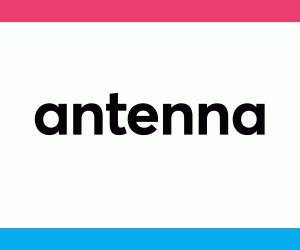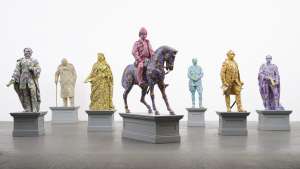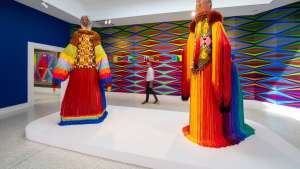Part of the Project
We’re just over a week away from antenna 2018. Curated by Design Indaba and hosted by Dutch Design Week, antenna is a global scan of the world’s most interesting design graduates.
So far, we’ve released 10 graduates from schools all over the world, and along with 10 more, they’ll present their projects at the conference on 22 October.
The latest batch of graduates provide insights into the world that are at times tangible and at times speculative.
Design between strangers
Boijman’s Launderette by Design Academy Eindhoven graduate Manon van Hoeckel is a fully functioning laundrette designed to foster communication in an unlikely space.
Located right in the middle of a museum at the exhibition ‘Change’ in Rotterdam, the laundrette responds to the world’s diminishing spaces for spontaneous conversation.
From online banking to food on demand, the chances of meeting a stranger are disappearing fast. When we talk to those we see as “other” it’s a chance to gain not only insight but also empathy.
One could argue that the disappearance of these spaces could significantly impact a refugee’s progress in a new country.
Asylum seekers are not allowed to work in the Netherlands but, by taking advantage of a loophole in a freedom of the press law, refugees are allowed to sell printed goods in a public space.
In a project called Printed Matters, the Dutch designer created portraits of refugees who then sell their prints, blurring the lines of labour and art.
Dignity, Independence & Craft
Arthritis, osteoarthritis, burns sequelae or amputations of hands are among several conditions that can lead to partial or total atrophy of the hands.
Because the hands become cocoon like, everyday tasks like eating, writing or cleaning are nearly impossible without help. Oliber is a low-cost solution to this problem designed by Bárbara López Anwandter from the Universidad del Desarrollo in Chile.
It’s an easy to use, inexpensive magnetic mitten that allows people with atrophied hands to pick up objects via magnets and metal plates, enabling users to eat by themselves, brush their teeth, write with precision, draw, hold up their phone, and many other tasks.
The magnets allow users to hold up to 2.2 pounds. For objects that are not metal, Oliber comes with four metal plates that can be stuck to anything the user needs.

Docu-Fictional food
Lichen, along with algae and insects, show great potential as a superfood. But unlike its counterparts, it’s so resilient that it can even survive on Mars.
Unseen Edible by Julia Schwarz from University of Applied Arts, Vienna, is a speculative look into a future where linchen is already on the menu.
Speculative projects like Schwarz’s are not far-fetched. According to the Independent, overpopulation and climate change will lead to a global food crisis by 2040.
With this in mind, Schwarz had a closer look at what people ate during times of famine. She found that lichen, a symbiosis of fungi and algae, showed up several times.
“Starving people weren’t dying anymore and they didn’t have even deficiency symptoms,” she writes.
Her film is a glimpse of a world where lichen is already implemented as an everyday food source and offers a glimpse into the way our eating habits may change in years to come.
Community self-empowerment
South African designer Nicole Nomsa Moyo created Ukubutha as a way for disenfranchised communities to empower themselves without depending on government assistance.
Service delivery after the weight of the Apartheid government is still almost non-existent in impoverished places in South Africa. Ukubutha, which means ‘to gather’ proposes a waste-to-energy design with socially driven architecture.
The sanitation hub aims to empower and collectively solve the underlying needs of access to adequate sanitation, a safe source of water and the production of energy.
An independently built water, sanitation and energy hub, Ukubutha provides materials, system mechanisms and spatial qualities based on a response to social and environmental awareness.
The design is aimed at assisting the relief of service delivery backlogs for the government, municipalities and communities in, but not limited to Pretoria, South Africa.
The sanitation hub would provide on-site fabrication of recycling and resource recovery. Ukubutha is about creating sustainable environmental spaces for collective engagement and wellbeing.
Moyo conceptualised the project at Carleton University in Canada.
Techno-ecologies and social engineering
Bitcoin’s energy bill is growing to environmentally disastrous proportions at a global scale, says MIT student Gary Zhexi Zhang.
Touted as a trustless system, blockchain protects itself from malicious intent through a series of computational methods, cutting out the need for traditional centralized social institutions, such as the administrative work of banks and governments.
Its mechanisms also replace the physical labour exerted by these mechanisms in the name of maintaining order and trust. But blockchain does produce heat.
Zhang’s project, Farm is a speculative exploration of the question: How much energy does it take to maintain a society?
The project seeks to explore the question by making the investigation palpable. Farm I (parasitic shrimp farm) replicated this relationship within an ecological system. Farm II (sacculina) replaced the shrimp in the first system with people.
The next iteration will take place at the antenna exhibition at Dutch Design Week.
Like the antennae of the natural world, antenna aims to intuitively spot and react to the subtle signs in the world around us. The last of the antenna line-up will be announced in the coming days and keep an eye out for the first antenna exhibition. Buy tickets now.
More on antenna 2018 and its speakers
Empathy: a quality that binds design across disciplines
Behind antenna and its impact on future changemakers in design









